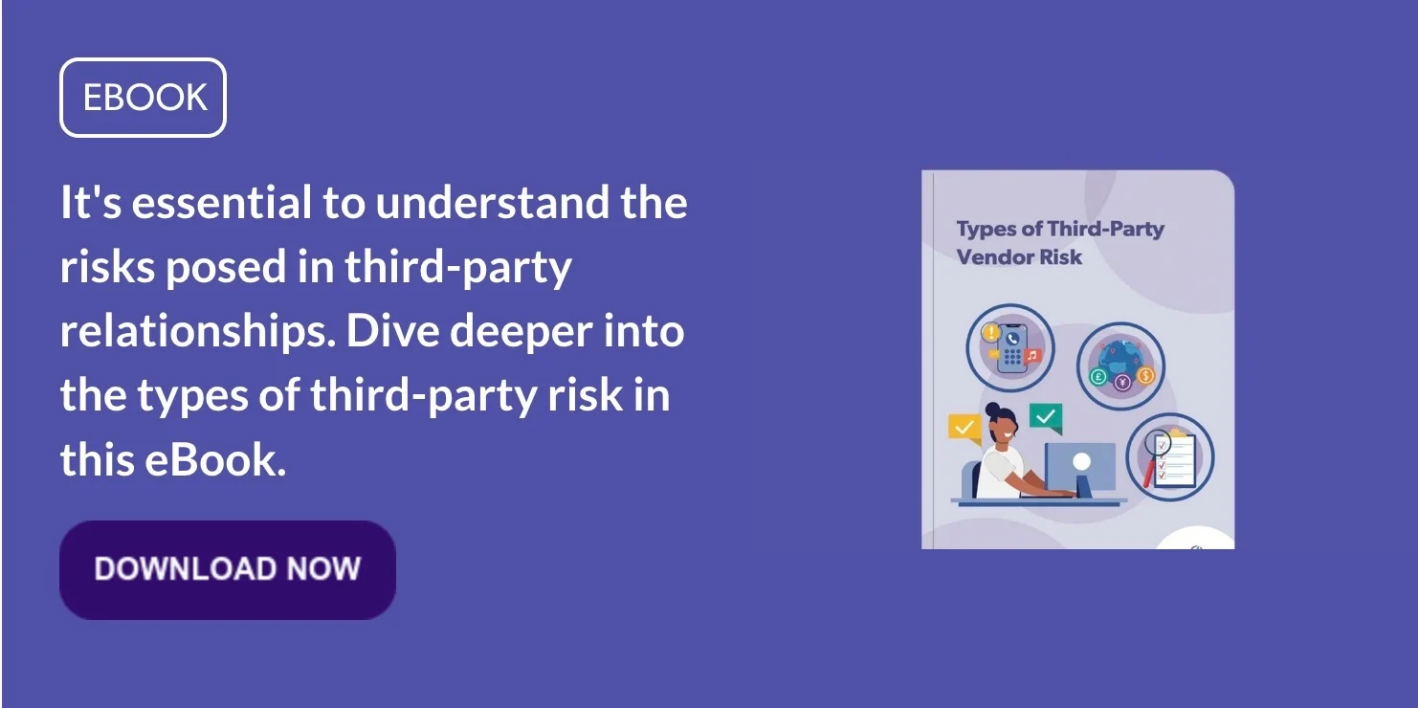Whenever you obtain a product or service from a third party, you expose your organization and your customers to what is known as third-party risk. The specific types and amounts of risk present in a third-party engagement will vary greatly depending on the product or service. Identifying and understanding these risks is the first step in managing them.
Read on to learn more about the most common risks your organization may face when purchasing products and services from third parties.
Understanding What Third-Party Risks Are
The term “third-party risk” refers to any risk introduced to your organization or its customers through an engagement with a third party. Third-party risk management is the process and practice of identifying, assessing, and managing those risks.
Before we dive further into risk types, there are two risk categories to understand. These are known as inherent risk and residual risk:
- Inherent risk is the natural or raw risk that occurs or is associated with a product or service and, therefore, the third-party relationship. The measure of inherent risk doesn't account for any existing or future controls that may reduce those risks' likelihood, occurrence, severity, or impact.
- Residual risk considers the amount of remaining risk after controls have been studied and substantiated. By measuring residual risk, you can evaluate how effectively the third party's controls address the inherent risks.
Often, the third-party controls can adequately address the risk, justifying your organization's decision to move forward with the relationship. However, controls are sometimes insufficient, and the residual risk may be too much for your organization to accept, resulting in a decision to avoid the relationship altogether.
Types of Third-Party Risks
There are various risks depending on the type of third-party product or services your organization uses. Let's look at several of the most common types of third-party risks:
- Strategic risk occurs when your third party's actions and/or decisions fail to help your organization meet its goals and objectives. For example, if your third party uses outdated technology, it may become difficult for your organization to perform normal operations.
- Compliance or regulatory risk happens when your third party fails to comply with laws or industry-specific guidelines. Your organization is liable for your third party's compliance and can be subject to legal action if your third party violates regulations. Examples of compliance risks include violating consumer privacy laws or having insufficient cybersecurity practices.
- Cyber or information security risk includes both cyber and physical security risk. It’s present whenever you have a third party that accesses, transmits, or stores your organization's sensitive data or that has access to your privileged networks or facilities. The threat of third-party data breaches has grown as hackers have developed more aggressive and sophisticated ways to breach private networks. Any gaps in your third party's controls must be addressed to protect your organizational or customer data.

- Financial risk exists when your third party has poor or declining financial health. Increasing costs, decreasing revenues, or losing a major customer can force your third party to discontinue a service or product that is crucial to your business or they may go out of business entirely.
- Operational risk is present when a third party's product or service is necessary to maintain your organization's daily operations. Suppose a business-disrupting event, such as a system failure or natural disaster, occurs and interrupts normal operations. In that case, your third party must have adequate plans to continue service at agreed-upon levels or resume operations within a given time.
- Concentration risk occurs when your organization obtains several high-risk or critical products or services from the same third party. Suppose the third party suffers a major business interruption or failure. In that case, your organization will be impacted more severely than if the products and services were provided by different third parties.
- Reputation risk occurs when your third party's actions or decisions impact your customers' perception of your organization. For example, suppose your organization suffers from a third-party data breach that resulted from a gap in your third party's security. In that case, your customers will have a negative opinion of your organization. Other examples include bad customer reviews, lawsuits, and negative publicity.
It's important to note that these are only the most common types of third-party risks that your organization may face. There are, of course, more risks (such as geopolitical and ESG risks), and new risks are always evolving. Therefore, it’s crucial to perform thorough risk assessments to identify and understand the risks that must be managed to safeguard your organization and its customers.
Every third-party relationship contains some risk; however, to manage those risks, you must first fully understand what third-party risks are. You must remain diligent as your organization outsources products and services and be aware of the risks posed by third parties.






.gif?width=1920&name=Sample-Graphic-Animation%20(1).gif)




